Best Free CRMs:
Membrain Free CRM Review
This review of Membrain free CRM was done using CRM Testing Methodology v2.
Picking a system to run your sales operations on can be a frustratingly difficult task. That’s why we’ve devised and keep developing a standard method for reviewing CRMs. To help you find out if it’ll work for you, so you don’t have to.
Let’s talk briefly about the scoring in CRM Testing Methodology v2. Membrain has succeeded in putting out what to our best knowledge and insight is the best free CRM out there. It is in all likelihood the best-paid CRM as well for many organisations. Our 1 through 10 scoring system has been put to the test. The general expectation is that freemium solutions will have a free version, which is ALMOST good enough to pass as a fully functional offering. Because of that, they’re likely to score no higher than 4 to 6 in our testing.
That Membrain scores higher in most categories, poses a challenge to current dominant players in the premium offering game. How can they explain to customers that they must pay for basic value when Membrain aggressively puts that value at 0 and charges for advanced value?
Dive in and think about how this might work for you. Contact us as well and book some time to talk it over. Always happy to discuss. If you’d like to give Membrain a spin, do check out this free trial of the full suite.
Over to the rest of the review.
Highlights of the Membrain free CRM review:
Likely the best free (and possibly the best paid) CRM out there. Both free and paid versions are a sales system in a box.
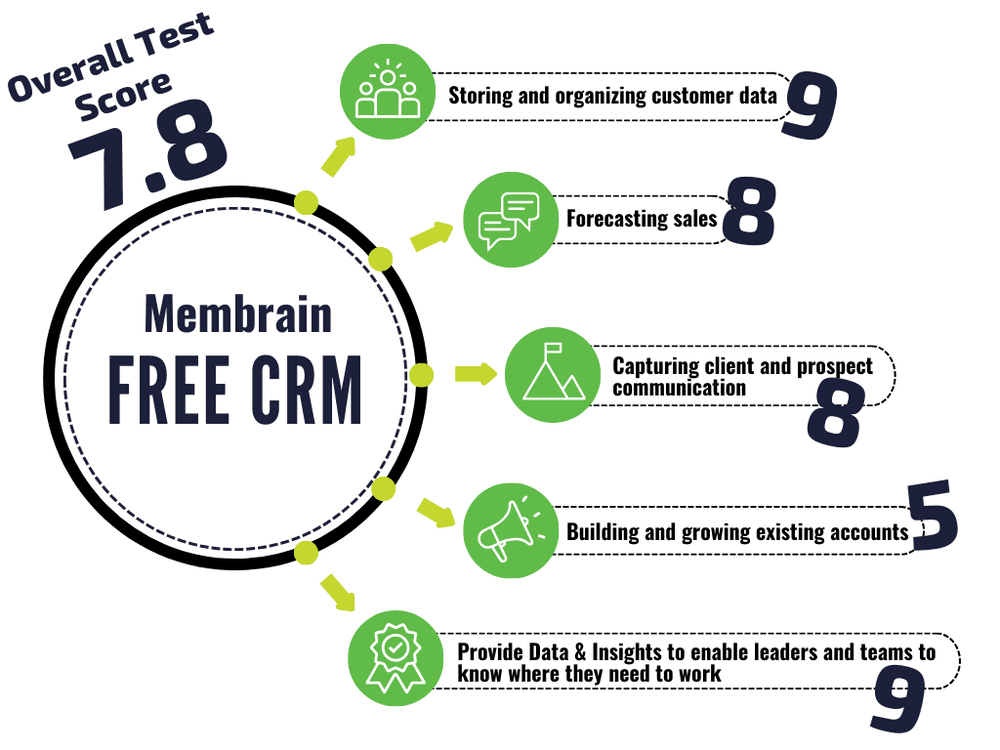
Brief Intro to Membrain
Membrain provides a Sales Enablement system and CRM for B2B sales, crafted originally by George Brontén and the Membrain team from their experiences with scaling sales teams. It’s fair to say Membrain is different.
The complete platform aims to refocus sales strategies around the “how” of selling. It integrates tools for prospect engagement, pipeline management, and account growth. Designed for global use, Membrain serves clients in over 80 countries. What’s important is they promote a structured approach to sales that emphasizes methodology and strategy over and above just traditional CRM functions.
With capabilities for integration and a mobile app, plus plenty of sales productivity tools, Membrain positions itself as an innovative solution for sales teams. Membrain is a particularly good fit for sales teams seeking a structured yet adaptable sales process. Its accolades in the sales technology community underscore its role in evolving sales enablement, offering a blend of technology and strategy to enhance B2B sales outcomes.
How and What We Test
You should have a look at the testing methodology to see the items we’ll test for and why. Here’s what you’ll find in this review about Membrain’s free version – and to some extent their paid versions as well:
- Storing and organizing customer data
- Forecasting sales
- Capturing client and prospect communication
- Building and growing existing accounts
- Provide Data & Insights to enable leaders and teams to know where they need to work
- Cost-drivers
- Conclusion
Now, let’s dive into Membrain and see how it works!
Membrain free CRM for Storing and Organizing Customer Data
This is where most people will start. After all, when it comes to storing and organizing customer data, a CRM is very much a system of record. First, then, we’ll need some records. Most people will start with some sort of list of accounts or contacts and thus will make use of the import feature to get started.
If you’re coming from a different system, importing appointments, notes, tasks, deals (”projects” in Membrain lingo), and products follows the same process as with companies and contacts.
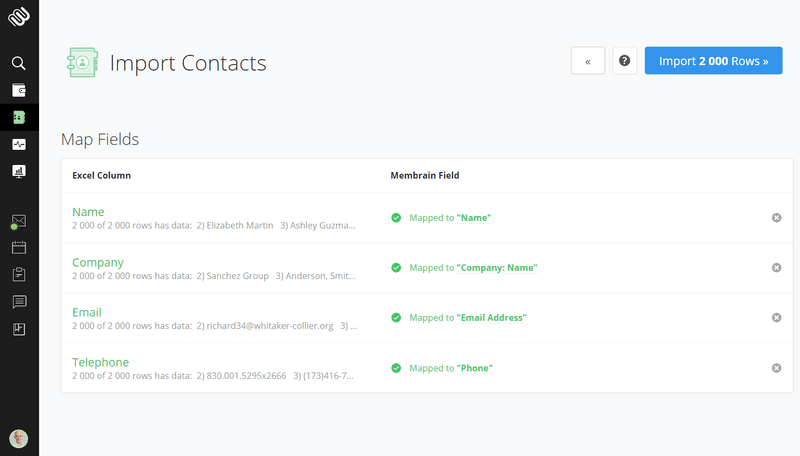
Getting Started
The import feature is very easy to get going. You simply feed it an XLS or XLSX file with your data, map it, and off you go. Free versions often come with limitations in terms of the amounts of records you’re allowed to store within a CRM. In past reviews of free versions of monday.com and Agile CRM, the limitations have been along the lines of 500 records or maybe a few 1000 records.
Not so with Membrain, which happily allowed an import of 20.000 contacts + 17.000 companies!! Membrain’s Founder, George Brontén confirmed that in fact, the number of records you can include in the Membrain free CRM is ∞ (infinite). That’ll do it for most people. 😉
Modelling Your Data
It’s not just about the data volume, though. While we only mapped 4 data types in our import, you could really add quite an incredible amount of customer information. This goes for both company and contact records. One small detail we liked in particular, is the ability to note if a contact has left a company. That’s something even paid CRMs struggle to manage really well.
You can create new labels for both companies and contacts and with that create very, very specific custom targeting. Think about what you could do if you could group people by country, industry, seniority, and the language you speak with folks – all at the same time.
And if all of that isn’t enough, you can create your own custom data types based on any of the 13 available data formats, such as text, and number. More advanced formats, like the “scorecard” datatype, are also available.
Finally, you can create all sorts of custom filters, based on any available data type, save them for later and even share them with any of the other 7 users in your free Membrain instance.
Solid Personalisation with Membrain free CRM
This all enables highly personalized customer experiences because you can tweak and enrich all your communication using the datatypes stored in Membrain. You will be better equipped to detect commonalities in your market segment if you organise your data better. This should lead to a better understanding of your ideal client profile and buyer personas. Improved understanding of your target market leads to improvements at all stages of the sales process, from marketing and lead generation to negotiation and closing.
Structure it well, making use of that Zapier integration makes integration with Customer Success and ERP possible, providing sales with information about customer issues and billing – right in the CRM. This further increases sales’ ability to personalise the experience for customers to ensure decreased churn and increased expansion.
Does Membrain free CRM Help Keep You Compliant?
In Europe without a doubt GDPR is the set of regulations, which get the most attention from marketing and sales VPs alike. That’s because it can get somewhat complicated. Start with this list as a starting point for complying with GDPR:
- Where did you get the data?
- Which data did you collect?
- What is your reason for collecting this data?
- How is collected data processed?: Where is it stored, who has access, and to what end?
- When is the data disposed of? What’s the process for that?
- Did you obtain consent to collect the data?
- Does the collected data include sensitive information? These are subject to higher levels of protection and include genetic, biometric and health data, as well as personal data revealing racial and ethnic origin, political opinions, religious or ideological convictions or trade union membership.
Membrain free CRM has features in support of GDPR’s “right to be forgotten” and “right to access” and they provide an article for your GDPR reference here. They’re ready for you out of the box.
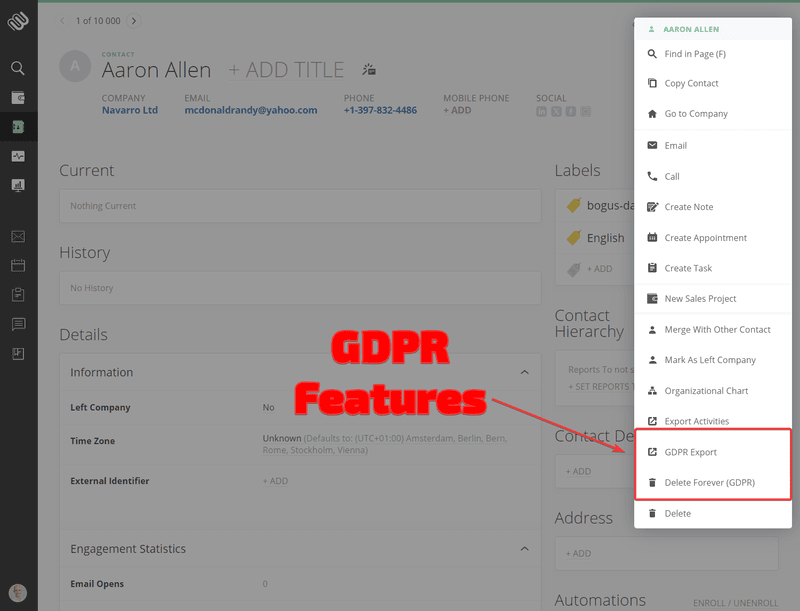
Similar features exist in other CRMs as well. Membrain is just very explicit about what these features are in support of. That covers GDPR’s right to be forgotten and right to access. With regards to the bullets mentioned above, Membrain doesn’t directly include features specifically designed for GDPR-compliance, but it is VERY easy to create custom fields and processes to cover remaining GDPR-compliance. Last note on GDPR: Users in the European Union should feel happy about all data staying in the EU as Membrain’s servers are located in Sweden.
Data Sources – Where does data flow to Membrain free CRM from?
As previously explained, Membrain comes with Zapier integration baked in. That’s great! Zapier can be a valuable component in a company’s tech stack for all sorts of integrations. Zapier even comes with a free plan – with 100 tasks per month. So… with the perspective of this review testing out Membrain free CRM, this limit with Zapier will swiftly have you run out of tasks.
Of course, your Office 365 and Google Workspace Calendars and Email don’t go through Zapier and just work, as do Zoom, Slack, and the Membrain API. You could use the API to integrate with Make, Pabbly, Activepieces, or similar, but that’s more technical than we’d like to see for an SMB organisation.
Also, from the perspective of just remaining flexible with data sources, a link to integration software, like Make or Activepieces, would be very helpful.
At this point, though, we’re looking at very fine detail. Let’s move on to scoring. Membrain’s free CRM gets a score of 9 out of 10 (Very good) for its (lack of) ability to store and organize customer data.
Pros:
- it’s just near-perfect.
- solid GDPR-compliance implementation.
- good data source integration.
- very flexible databases for handling contact and customer data.
- limitless numbers of data records.
Cons:
First a word on these: we tried very hard to find cons. All we came up with are these MINOR items:
- possibly, one could have pre-created the final few GDPR-supporting data elements.
- Out-of-the-box integration with the likes of Make or Activepieces would have been truly great.
Forecasting sales with Membrain Free CRM
Since forecasting is essential to sales teams, any CRM – free or not – must provide tools to make forecasting as easy and as accurate as possible.
Sales forecasting is required to:
- See if you’re delivering on expectations (goals)
- Enhance Revenue Predictability
- Improve Inventory and Supply Chain Management
- Create Effective Sales and Marketing Strategies
- Improve Cash Flow Management
- Improve Project Management and Delivery Times
In order to understand forecasting with Membrain, it’s important to see how you manage deals because Membrain in several ways takes a different approach than most other CRMs.
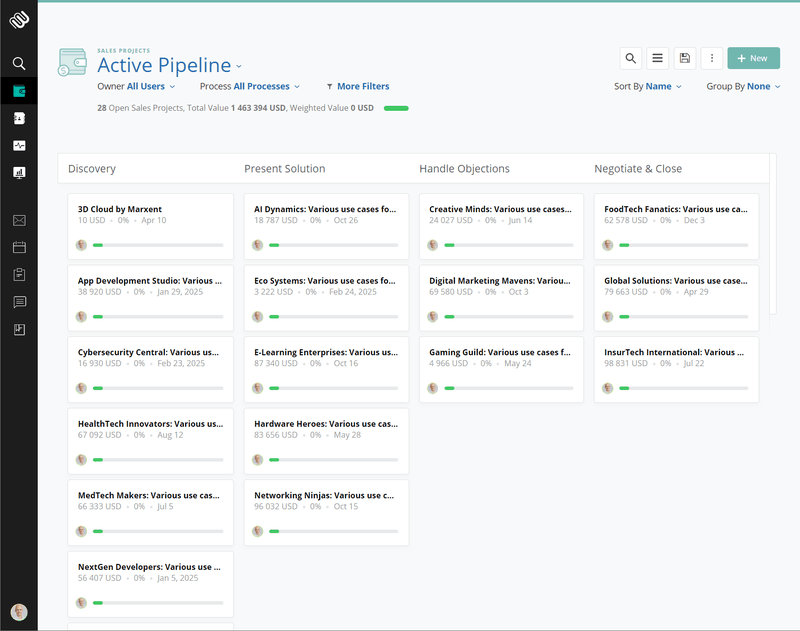
How You Sell Matters
Initially, you’ll need Sales Projects to form a pipeline in Membrain. This can be done manually, and if you’re coming from a different CRM, as with contacts and company data, the import is really easy.
IMPORTANT: Notice in our import how what looks like a standard kanban board has one critical detail. Most other CRMs would calculate closing chance based on some sort of automated deal stage calculation. Not so in Membrain free CRM. Instead here’s an important part of what truly sets Membrain apart:
What you really want when forecasting, is to understand your own deals. You want to understand them so well that you know that a deal with milestone ABC successfully passed has X% chance of closing. As deals progress through their journey towards the close, that percentage should update automatically AND/OR you should be able to adjust your win chance percentage manually and have the forecast reflect deal value * deal win probability.
Deal Stages vs State of the Deal
Other CRMS most frequently take the path of assigning a closing chance percentage value to each deal stage. The problem is that a seller can for instance arrive at the negotiation stage and find that they’re missing a key buyer persona or you missed a competitor. This reduces win chances. While the seller thinks they’re about to win, they really might be about to lose and ascribe the loss to “internal politics”, simply because they blasted past a critical milestone. Not only may they lose, but they’ll also learn absolutely nothing!
The Membrain way is this highly valuable variation on that theme:
Create your own sales process (1 available in the free version). When you design the sales process, you’ll find that you can associate percentage values to each. These are incremental percentage point values, which will add up to a maximum 100% win probability when you carry them all out working through your sales process to win a deal.
Activity-based Deal-scoring is better than Stage-based Weighting – Why?
The distinction is important: The win chance increases based on how well you’ve covered your bases, not based on whether the customer would like to negotiate or not! And the distinction goes even deeper: when you configure your sales process, you can determine what should be included in the definition of any milestone.
For instance, you could attribute a level of importance to a specific element. Let’s say you’re in a market which is particularly fierce competition – then you can configure that the step “competitor research” should have a higher level of importance.
If a deal passes the deal stage where competitor research should be done, without checking that box, the deal will be deemed to be unhealthy. The health-grade will be attributed to the deal based on the level of importance you’ve assigned to that activity. If it receives a yellow or red flag the deal will no longer appear in your weighted pipeline and it will be archived 14 days after. Essentially the deal is deemed lost because of poor deal management and the system takes it out of your pipeline, based on your own sales process settings.
Tell Me What to Do Next
Also at this place in the sales process configuration, you can determine if the right step is to make a call, create an appointment, simply check a box, or make use of any one of the 20 elements that are available in the details/tools part of the definition of each sales process step.
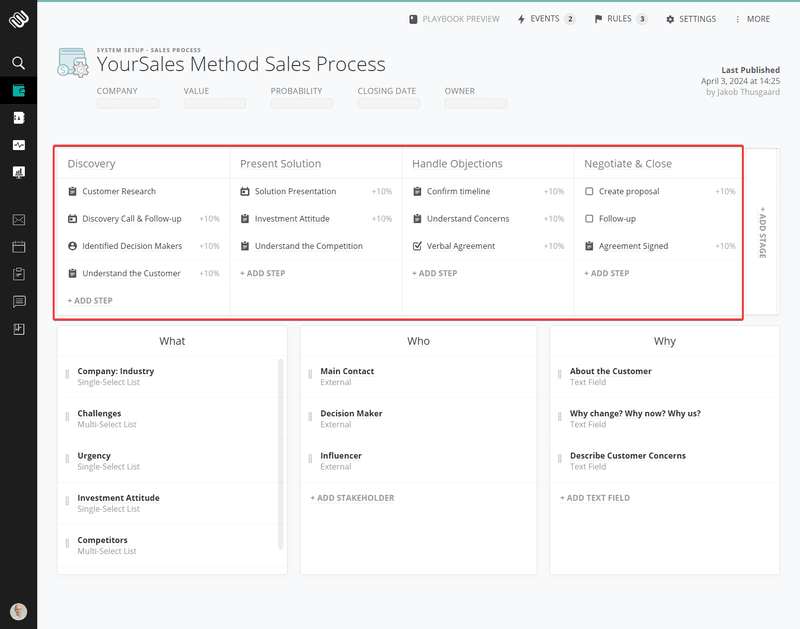
But wait, there’s more!: If your sales process truly reflects how you sell, managers can use these milestones for deal reviews and sales reps can self-coach on what they should do next. Lost deals no longer are lost to “politics”. Instead, they’re lost to not having identified the decision makers of not having made a verbal agreement – or to whatever other milestone is critical in your business.
That covers what sets Membrain apart as far as deal management is concerned. Still, remember the 6 points of sales forecasting listed above? Go ahead and check them out again, we’ll wait…
…Done?
OK! Here we go.
More Accurately Forecast Better Performance
Membrain free CRM comes with the Active Pipeline analytics module. It’s a valuable module, which shows you how you perform against goals for the current fiscal year. To make it really solid, as with other CRMs, you’ll see the value of the weighted pipeline, which is scheduled to close within the current fiscal year. As mentioned previously, though, Membrain takes things up a notch by basing reporting on how you’re doing against your own sales process instead of some fairly arbitrary deal stage conversion rates. In other words, if you just follow your process, you’ll have a higher chance of getting your forecast right.
Active Pipeline Analytics will also share with you your pipeline health. We previously covered how you configure a sales process and how you can attribute a level of importance to each step in the sales process. A flag is triggered if an important step is skipped in working with a deal.
Flags come in the form of a status and a delay with which the flag takes effect. Statuses are either coaching advice, yellow flag, or red flag. These can’t be edited. The delays are configurable and can be whatever you want ranging from instantly to 99.999 days, hours, or minutes, calculated from the moment the important step was skipped.
If a flag is raised, it will have impact on the health analysis of the entire pipeline. Also, as previously mentioned that deal will no longer be part of your weighted pipeline, until the problem is fixed, of course.
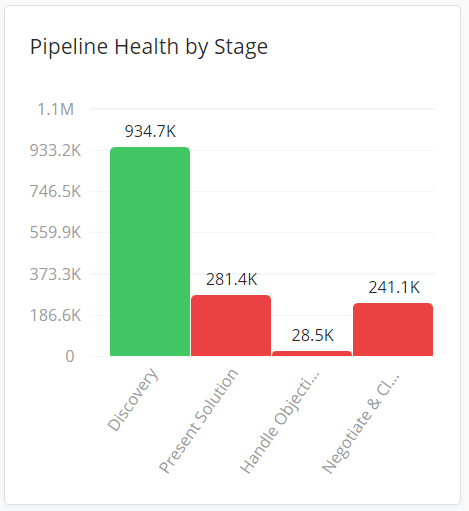
Am I on a Path to Success?
That’s not all, though. You don’t just want to know if you seem to be about to be performing against goals. You also want to know if your current KPIs take you on a path to future success beyond your current pipeline.
That’s why Membrain has three types of goals:
- Outcome goals: your regular accumulated deals won value.
- Effectiveness goals: For instance win rate, average deal size, and sales cycle length. Essentially they are metrics you only have indirect influence over through customer-facing activities.
- Activity goals: This is the input to the pipeline. The sales activity. For instance, the number of companies with activity, and number of completed activities be it email, calls, notes, appointments, etc.
Sales Performance Management in Membrain free CRM
While the pipeline analysis deals only with revenue and profit, the performance tab under Sales Analysis specifically helps you with sales performance management. It will tell you if you’re currently delivering across all goals and it has views for the number of current deals, win rates, average deal size, and length of sales cycle.
The eagle-eyed reader with elephant memory will immediately see that these components make up the sales velocity equation – an invaluable tool in calculating when you’ll reach what given current performance.
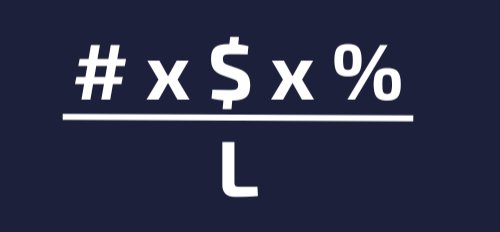
In short, Membrain enables us to:
- See IF we’re about to reach our goals, when and how much, increasing revenue predictability.
- See WHY we’re reaching our goals or why not.
- We’re able to create products in Membrain and forecasts reporting in Membrain can split out these products, be they physical, services, or virtual. This helps greatly with capacity planning, inventory, and supply chain planning. That leads to cost savings and a greater ability to deliver outside just the sales team.
- Based on findings from the sales process, you can detect patterns with your ideal clients. This in turn enables your marketing efforts to be more targeted, using what works.
Which kinds of sales funnel analytics aren’t easy with the free version of Membrain’s CRM?
One of the things you’d like to include in forecasting is predicting the required sales staff for various parts of the sales funnel. Membrain’s 🔭Prospecting product is an upgrade from the free CRM. As the name suggests, it’s built specifically for finding new customers using a streamlined process. Analysis of the prospecting process is part of the Prospecting product.
You COULD define a sales process in the free version, which includes lead generation. It would have to include specific actions for sales development in the wider sales process. The trouble is it would only kinda sorta work – and realistically only for a single channel. At an early stage MAYBE you can get away with just doing outbound, but later on, as your channels for lead sourcing grow, it will become a mess.
The challenge for other CRM companies is: How do you explain to customers that they must pay for basic value, when Membrain aggressively puts that value at 0 and charges for advanced value?
In addition, if you just build prospecting in the free CRM, you get none of the analytics that the Prospecting tool is big on. This is a challenge in the free CRM.
This lack of insight from the free version of Membrain’s CRM doesn’t change the fact that for sales forecasting, Membrain is definitely useful. This is true by the way, for both one-off transaction-based companies as well as for recurring revenue models.
Membrain gets a score of 8 out of 10 (good) for its ability to forecast sales. It gives rather elaborate forecasting to non-recurring revenue companies and recurring revenue companies alike. The reporting seems reliable and is easy to create.
Pros:
- Forecasting seems reliable and based on real-world sales opportunities due to the way Membrain suggests you sell. It turns out how you sell matters.
- It’s easy to view existing out-of-the-box reporting, and you can create own dashboards as well.
- Sales forecasting is based on doing the right things in deal management. This improves how you sell and positively impacts conversion rates, deal sizes, sales cycle lengths, and the number of concurrent deals. This is to say that the benefit of just the forecasting module goes much further than the traditional benefits of sales forecasting.
Cons:
- Difficult and cumbersome to create forecasting of personnel needed at the very top of the funnel in prospecting. This is intentional, of course, as it really doesn’t fall within the scope of Membrain’s CRM, but instead is covered in its Prospecting product.
Capturing client and prospect communication
When you’re selling to a customer or helping them buy, you need a number of things to come together. At the very foundation of every sale lies an in-depth understanding of the project that the client is working on. In a world where sales aren’t alone in winning customers, but rather also function as orchestrators of company resources, you’ll want to have a record of all communication with the client. That way, other team members can improve their understanding of what’s important to the customer, when Sales aren’t available.
Also, it WILL happen that a sales rep changes roles internally or especially externally in the middle of a sales process. Handover to a sales rep who’s taking over that market becomes infinitely easier when the CRM is up to date and includes previous communication with the customer.
Handovers to Support teams or Customer Success teams are also aided tremendously by up-to-date records in a CRM – including all communication.
In short, the name of the game is the centralisation of all communication. Membrain makes this possible to a high extent. The aim is to create a single, unified source of truth.
Email Sync with Membrain
If you email and call your customers, Membrain has you covered – if work from the CRM. In Membrain you can email from the Sales Inbox, which syncs beautifully with the main email inbox on either Google Workspace or Office 365. It’s a very nice 2-way sync, so when you archive an email in Membrain’s Sales Inbox it’s also removed from your inbox in Google Workspace or Outlook 365. It doesn’t quite sync read/unread statuses, but that’s unlikely to be something you manage your inbox by, anyway.
Making Calls with Membrain
When it comes to calling, the solution is semi-automatic and will also depend somewhat on your sales tech stack. For instance, if you’re trying to place calls on a mobile phone, you’ll need one of the following:
- The Membrain Go app on your iOS or Android device. Place a call straight from the app.
- Have your mobile phone connected to your computer, and configure the URIs so they can trigger calls on your mobile phone.
For example: a Windows 11 computer placing a call on an Android phone.
– get Microsoft Phone link on the computer and Link to Windows app from Microsoft on your phone.
– have them connect.
– configure Membrain’s Shared IP Call Settings under System Setup to reflect the way company computers handle IP Call Strings.
– place the call.
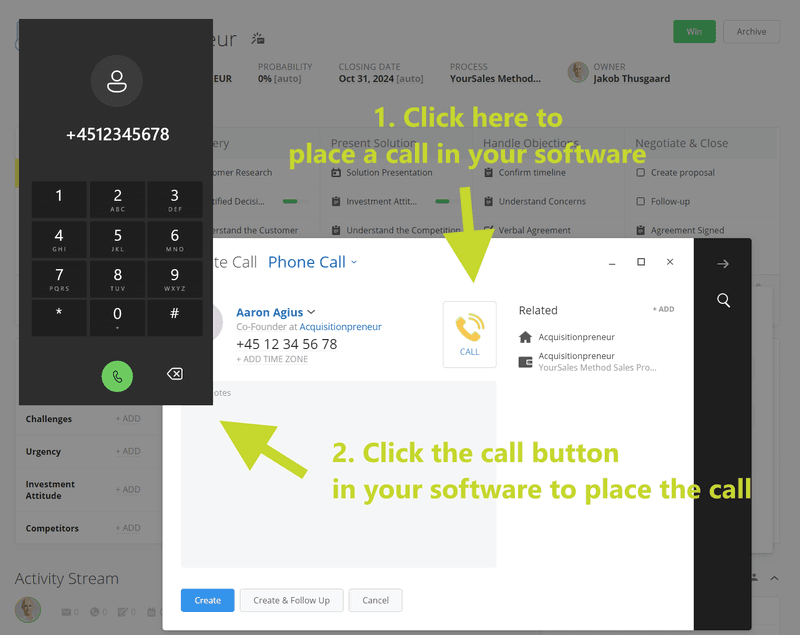
Desktop When You Can, Mobile When You Must
It’s highly recommended to have the Membrain Go app for when Sales is on the go. However, for in-office work there are benefits to working off of a computer: When you click the CALL button in Membrain or in the Membrain Go mobile app, the call AND the notes field will be on the device where you click the Call button.
When you use the Membrain Go mobile app, you’ll be forced to make notes in Membrain Go. That’s OK in a bind, but doesn’t work anywhere near as comfortably as the keyboard on your computer. It’s just way easier to take notes on the computer.
When the call is over, save the notes and create the call record by clicking “Create” or “Create & Follow-up”. “Create & Follow-up” by the way, opens a dialogue window with the aim of creating a follow-up task for yourself in Membrain. That task can be of any one of the 10 types available – plenty of flexibility for you. Of course, the semi-automated nature of saving calls in Membrain is necessary if you want to include manually typed notes before the call is saved.
It also leaves a tiny margin for error, though, in that it requires sales reps to initiate the call from somewhere within Membrain. If a sales rep initiates the call straight from a mobile phone address book, for instance, nothing in Membrain will pick up on that, and such a call won’t get automatically logged.
This “problem” is confined to just Android users because they have the technical possibility to have their calls logged in a system outside their ecosystem. iPhone users, on the other hand, do not have this option, so to the iPhone user this won’t feel like a drawback of using Membrain.
If you and your team use softphone dialers they will be able to both use Membrain and Membrain Go for calling, provided the appropriate softphone software is installed on the device they’re dialling from.
Using Other Communication Channels with Membrain
In order to turn Membrain into your single source of truth with regards to logging communication with customers, a whole host of channels remain to be explored. Most of the remaining channels, though, are notoriously tricky to sync. Sure, there are tools, which enable sync with SMS, Whatsapp, Meta’s Messenger, and many more. It’s just they’re all price, difficult to use, or both.
How about LinkedIn messages?
LinkedIn is tricky as well, but you CAN set up LinkedIn automation software via Zapier to look up company names in Membrain to associate with messages in your LinkedIn inbox. That is sales tech geekiness taken quite far. Send us a message with Whatsapp if you’d like to know more about how to do this.
Membrain’s free CRM gets a score of 8 out of 10 (Good) for its ability to capture client and prospect communication.
Pros:
- Good integration with emails and tracking of calls.
- It’s a 2-way sync!!! This kind of functionality is often reserved for paid systems.
Cons:
- As with most CRMs, connecting to traditionally closed systems remains painful, if not entirely impossible.
Building and growing existing accounts with Membrain free CRM
As we’ve explained in the past, the building and growing of existing accounts is far easier and cheaper than winning new accounts. It’s also the faster path to building a pipeline because you benefit from work you’ve already done in the past. Therefore it’s essential for any business.
Centralizing Customer Data
Fortunately, Membrain has done extremely well at providing a single source of truth, which is so absolutely essential for a real, frictionless understanding of the world as it is. In addition the available integrations for Office 365 and Google Workspace Mail and Calendar tools along with the integration with Zapier, you get really far in terms of understanding all you need about your clients’ communication.
Can You Enhance Communication and Collaboration with Membrain free CRM
With all that knowledge at your fingertips, the process of nurturing existing clients becomes quite simple. Just make sure to always have a value-creating task planned for any account, right!?
Automation and Workflow Streamlining
Membrain provides us with a single, free automation. Select between a number of types: Sales Project, Company, or Contact. You can for instance create a Company automation, which triggers a nurture workflow if a Sales Project has been won. That’s pretty smart. It’s easy to configure intervals between nurture tasks. Nurture flows can be really long, and creating them in the editor in case of any won deal is a breeze.
Data-Driven Insights and Reporting
As for data-driven insights in Membrain, we really do get quite a lot of insight. For instance, are there companies with won deals, are we missing out on communicating with any companies, etc?
What we can NOT do in the free CRM, is more structured account growth. Everything that relates to digging out the potential of accounts and matching that up with current commitment. The Account Growth module also includes easy tools to create and execute account plans. Account plans often get created and filed to never again see the light of day.
In Membrain Account Growth, the account plan is embedded in Sales’ daily work. This means that both executing an account plan and getting coached on how to do that even better become natural activities.
This is all in the Account Growth module, though, which isn’t included in the free CRM. You really only have two options: use makeshift imperfect constructs in the free CRM or bite the bullet and upgrade to Membrain’s Account Growth module.
Either way, Membrain helps over comparative software.
The Membrain free CRM gets a score of 5 out of 10 (Almost satisfactory) for its ability to help grow accounts.
Pros:
- you can use dashboards to determine who you’re missing.
- you can use automation to create 1 workflow for nurture.
- the Zapier integration and a dose of creativity should help you with even more automation.
Cons:
- While reporting IS available, it’s not really designed with account growth in mind.
- For next-level account growth, you’ll have to upgrade to Membrain Account Growth.
Provide Data & Insights to enable leaders and teams to know where they need to work
Creating guiding beacons in a sea of information. That’s what structuring data and creating insights is all about. Eliminating guesswork is the name of the game.
The insights we’re attempting to extract can be slotted into the following categories:
- Customer behaviour
- Market trends
- Team performance
- Individual performance
Out of the box, Membrain provides more useful reporting than any other free CRMs we’ve seen. Frankly, it’s equally tough to swiftly think of any paid options with more useful reporting.
Customer Behaviour and Market Trend Insights
When it comes to customer behaviour, Membrain’s free CRM help us by allowing unlimited records to be created in the CRM. It would be a correct point to make that you can only work on 50 concurrent Sales Projects, but you can organize your way out of that challenge by internally managing strictly what actually constitutes a Sales Project.
The customer behaviour analytics offered by Membrain live in the Sales Analysis feature, especially under Win/Loss and Content Hub Analytics.
Brief Introduction: The Membrain Content Hub
As part of any sales process, various pieces of collateral will be shared with potential buyers throughout the process. The Content Hub is where you upload the sales collateral required for a successful sales process AND content which your sales team can use to learn how to better navigate the sales process. When you upload content to the Content Hub, you also should assign a context to the content. If you do, it’ll come up in Membrain’s automatic recommendations for what content to share where in the sales process. Very useful!
When sharing collateral with buyers, they’re sharing a link to the collateral rather than a file, and engagement with such links can be tracked – as opposed to when you share regular files, which can’t be tracked.
Brief Introduction: The Beacon
Membrain’s tracking beacon sends a signal to the Membrain CRM whenever companies visit your website. You simply add a piece of code to your website’s pages. This allows you to get website visit information and to create leads from website visits automagically.
OK, so what does that mean for Customer Behaviour and Market Trends Insight?
First – the beacon: technically it doesn’t make up the Sales Analytics module. Instead, it’ll allow you to gain insights into customer behaviour related to website visits for buyers who are part of a Sales Project in Membrain. When a buyer visits the website a note is created on the Sales Project that the buyer has visited the website.
Second – the Content Hub: This is way more elaborate. Whenever you share a piece of collateral with buyers it will get read – fully, partly, or not at all. The Sales Analytics feature helps you understand, which content gets the best engagement from buyers. The Content Hub shows you metrics like:
- Top Shared Content
- Most Engaged Content
- Top Sharing Users
Actionable Insights Galore in Membrain free CRM
In addition, Sales Analytics make it possible for you to break that data down further in pretty much any way you want. This creates insights you can act on – insights like which content to use, which to dump, which users share collateral, which do not, etc.
Win/Loss Analysis
The final and very strong component to better understanding customer behaviour in Membrain, is the Win/Loss feature. It does what it says on the tin: looks at why you won or lost a Sales Project. There’s a lot to it. With the win/loss feature, you’ll be able to understand – scoreboard style:
- Your win rate – Losses vs Wins
- Why customers buy – or don’t buy
- Conversions from stage to stage of your sales process
- Win rate influencers (listed if an influence factor impacted winning or losing in at least 10 Sales Projects)
- The average age for won and lost deals
- The time at each stage of the sales process for both won and lost deals
- The average stalled time for won and lost deals
- The average number of activities for won and lost deals
- Average time spent on won and lost deals
- Number of stakeholders on won and lost deals
- Average value for won and lost deals
This is nothing short of amazing! Other CRMs – paid ones – have a tough time setting up this reporting let alone give you useful insights. In Membrain you’re getting it out of the box. You could argue that it just gives you a snapshot and you can’t really uncover trends in decision-making with the Win/Loss analysis.
That criticism would be misplaced. With Membrain’s Win/Loss analysis, you can easily filter pretty much any way you want, comparing deals from this year with deals from the past. It makes it easy to detect IF changes happen and to the extent that you have an impact on those changes, it’ll indicate what might be the reasons for the change as well. Granted, you would have to compare some of those reports manually, as the Win/Loss analysis isn’t available in the Membrain dashboard.
Team & Individual Performance Insights
An amazing amount of information greets you upon entering the Performance Analytics in the Sales Analytics feature. For each individual member as well as the team as a whole, you can dig into levels and trends for:
- Sales Overview – closed Won business vs sales goal for Fiscal Month, Quarter or Year and a whole host of other date ranges including a custom period. Reported on by Week, Month, Quarter, or Year for any sales process.
- Weighted Pipeline value
- The number of Sales Projects for the selected period
- Win rate
- Average deal size
- Sales Cycle Length
- Total Pipeline Value
- Performance against activity goals by type of activity
It’s incredibly actionable insights. There’s just so much self-coaching, team-coaching, and decisions you can undertake based on this information. And where you’ll have to go through manually comparing trends for customer behaviour, that’s NOT the case for performance graphs. They can be included straight into the dashboards for easy comparison, to support current initiatives for teams or individuals, and for easy future reference.
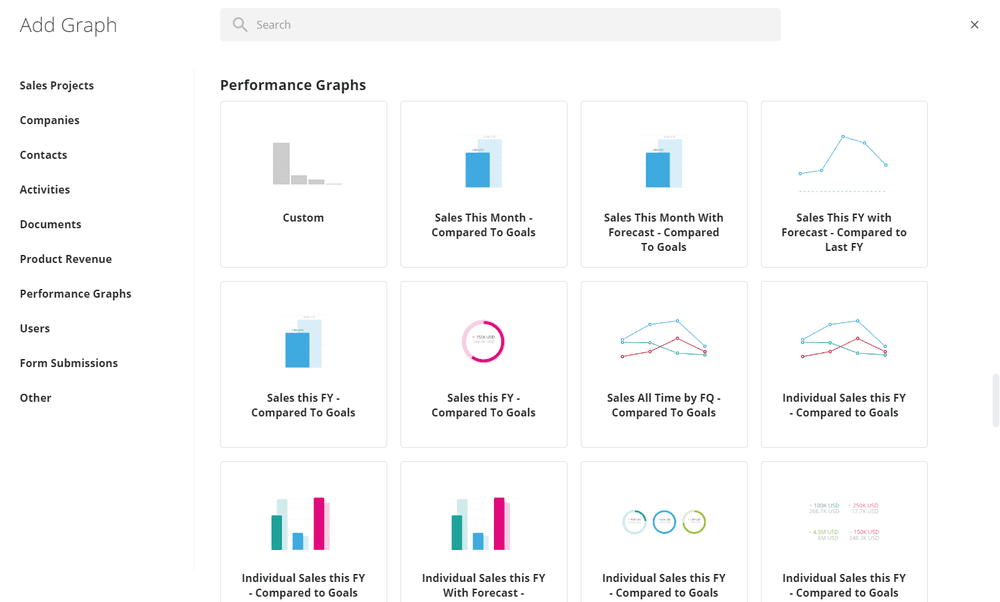
All in all, the breadth and depth of information insights available and the ease with which you access those insights should serve as an example for others to follow.
The Membrain free CRM gets a score of 9 out of 10 (Very good) for its flexible ability to easily provide leaders with data & insights.
Pros:
- Win/Loss Analysis
- The Beacon
- The Content Hub
- The breadth of performance insights for teams and individuals
Cons:
- We didn’t find any. Help us out – did you?
Cost-drivers – price required to sufficiently solve the 5 elements listed above
This is where we look at what happens IF you start using the free version, outgrow it, and start feeling a requirement to upgrade. If you’ve read this review from the top, by now you should have concluded that for small sales teams, it’s amazing what’s included in Membrain’s free CRM.
Several scenarios could cause an upgrade to any of the following three distinct products:
- Prospecting
- Active Pipeline
- Account Growth
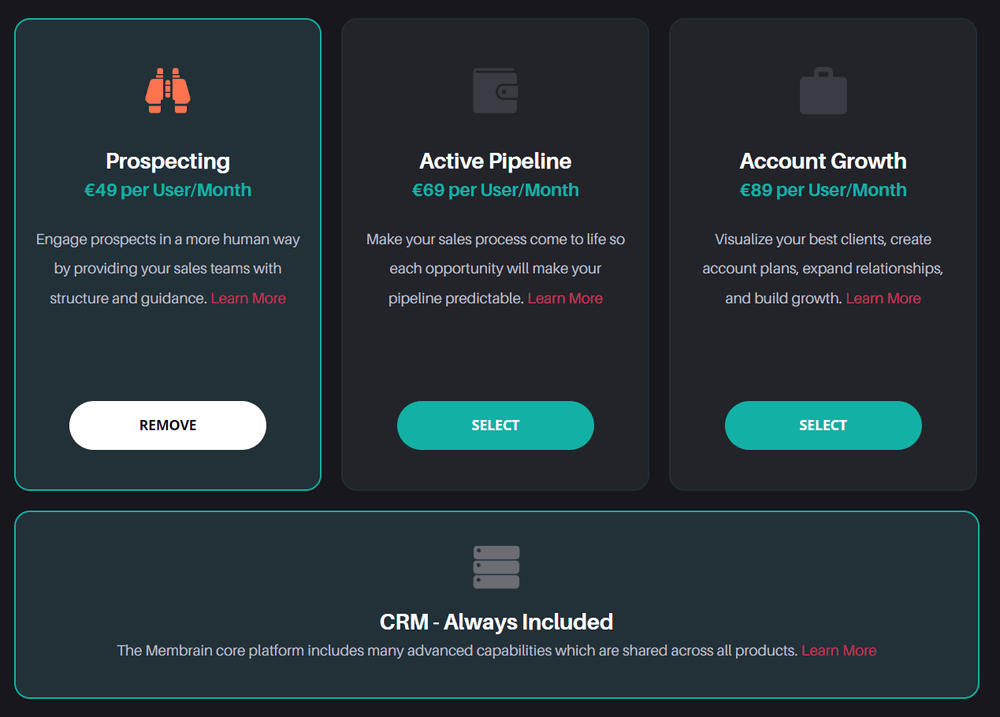
Bolt on Prospecting, extra Active Pipeline capacity, or the Account Growth module for everyone as you see fit.
Quantitative Cost Drivers
There are several quantitative elements, which force the default Active Pipeline upgrade:
- User count, Full or Lite: If you require more than 3 Full licenses OR more than 5 Lite users, all users will need to be upgraded.
- Sales Process count: If you require more than a single sales process, you’ll need an upgrade of the Membrain Active Pipeline for all who do deal management and all Lite users.
- Sales Project (deal) count: Max 50 open sales projects (= all deals excluding archived or won deals). If you have 2-3 salespeople that leaves about 16-25 open deals per rep.
- Integrations: If you require any of the integrations not included in the free product, you need to upgrade. To be specific, at the time of writing these are ActiveCampaign, Constant Contact, DocuSign, Google Drive, Hubspot, Mailchimp, Microsoft OneDrive, Objective Management Group, Oneflow, Refract, Salesforce, and Zendesk.
- Automation count: If you need more than a single automation OR you need more than the 100 daily automation steps (no limit on the paid Active Pipeline).
- Content hub, content count: If you need more than 10 collateral and 50 enablement content items, then it’s time to upgrade to boost sales content management.
- Dashboard count: If your need goes beyond 10 dashboards.
- API request count: If you need more than 5000 requests per day.
If you’re upgrading to bypass any of the limitations of the Free CRM, the upgrade path is always to Active Pipeline.
Functional Cost Drivers
In addition and at least as importantly, you may decide to upgrade to boost the value of Membrain. With increased value comes – and that’s fair enough – increased cost. Here are your reasons to upgrade:
Prospecting
Membrain’s Prospecting offering is an add-on to Active Pipeline Free or Paid. As with Active Pipeline, the Prospecting offering aims to streamline your prospecting game.
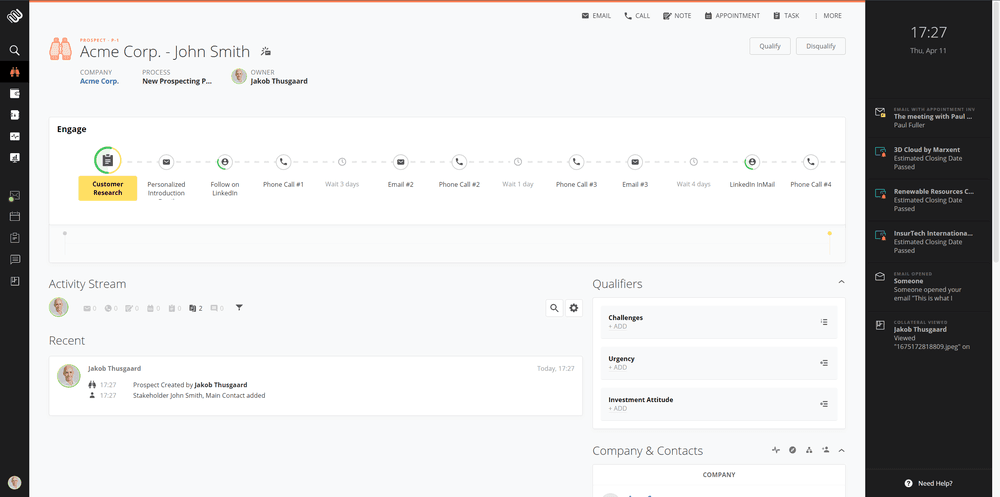
When you start the Prospecting product, at the outset Membrain will offer you to either create a process from scratch or use their suggestion. It’s great in that it forces you to go through a largely manual process, which ensures that you don’t make stupid automation errors. If you wish, you CAN enroll the prospect into automation at several steps of the process. Use this feature carefully and remember – you only have ONE automation as part of the Free Active Pipeline offering and more will trigger an upgrade.
One very well-thought-through feature of the standard prospecting process is that a nurture component has been included. This is often overlooked or created as an afterthought. Not so in Membrain!
Another useful feature in the Prospecting offering is the addition of Prospect Analysis in the Sales Analysis feature, giving insights in the same style as we already know from the free version of Active Pipeline, but now specifically useful for prospecting.
It’s fair to say that most of these features will be something most customers of other CRMs will need to invest in separately and won’t get from their CRM nor will it be connected to it.
Account Growth
The Account Growth module is another upgrade for companies with existing customers. What do you think is the first thing that happens when you start the Account Growth module for the first time?
You got it: It builds a process or invites you to build one.
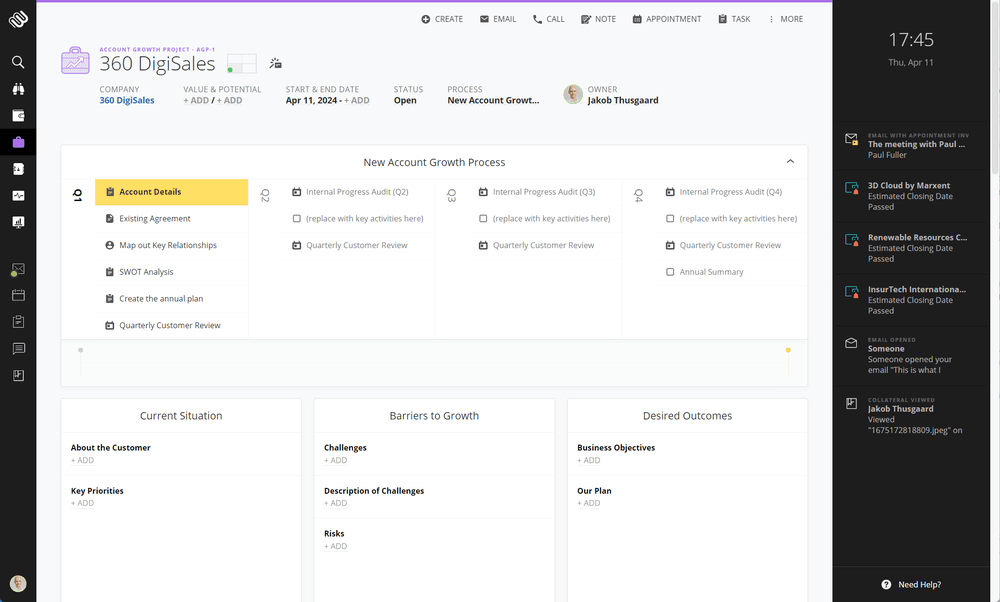
Account Growth is Membrain’s take on account management. All those things sales professionals have been taught for decades and which still work – they’re in the Membrain process. That turns every growth sales rep into a Sales Professional with a decade of experience. Also, this part can be used for sales coaching, so you can nail selling to existing customers.
One More Thing Gets Upgraded…
As the value of the overall Membrain implementation grows, so does the value of Lite users. In an upgraded Membrain setup, Lite users still exist and they’re €19 per user per month.
Membrain’s free CRM has room for up to 8 users. 3 of these users will have all the capabilities Membrain’s free CRM has to offer active salespeople. The remaining 5 licenses are for so-called “Lite” users. The basic idea is that Sales owns the sales process, and only active salespeople should be able to be “Full” users. Full users can That means Full user number 4 will require you to be bumped up to any of the paid versions. So will Lite user number 6.
What Will It All Cost?
Now, we could break it all down for you. You’d be happy with that. You’ll be even more happy with the pricing calculator Membrain created, which you can play around with and learn the price of Membrain’s components or the full suite.

Conclusion: Do We Have a Winner?
It should be clear by now that the free CRM offered by Membrain makes most other free CRMs look like embarrassing attempts at making sales software.
The thought that’s been poured into Membrain to align with what real sales professionals experience and are challenged by daily is second to none.
During this review, we’ve presented you with both the pros and the cons. It’s been easy to identify the pros and challenging to find the cons. The ones we found were marginal. This looks a lot like the best free CRM out there.
And sure: Equipping your sales professionals with paid Membrain products may add up to about 5% to the direct cost of that full-time employee – probably less, though.
Starting with the free CRM seems like a good way to start building your sales process. Once you see if it adds more value to your top and bottom line than they charge, the decision should be easy.
If you feel like checking out Membrain, use the tips and insights in this review and go grab your trial here. We’re rooting for you – happy selling!

